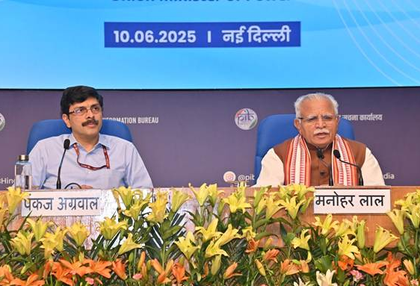India has met peak power demand of 241 GW with zero shortage, on way to turn power surplus: Manohar Lal
By IANS | Updated: June 10, 2025 20:18 IST2025-06-10T20:11:00+5:302025-06-10T20:18:26+5:30
New Delhi, June 10 Union Power Minister Manohar Lal on Tuesday declared that India has successfully met its ...

India has met peak power demand of 241 GW with zero shortage, on way to turn power surplus: Manohar Lal
New Delhi, June 10 Union Power Minister Manohar Lal on Tuesday declared that India has successfully met its peak electricity demand of 241 GW on June 9, with zero shortage, which shows that the country has become power sufficient and is now on track to become a power surplus nation.
Addressing a press conference here, the minister highlighted that India added its highest-ever generation capacity of 34 GW during 2024-25, with renewable energy accounting for 29.5 GW. The country’s total installed capacity now stands at 472.5 GW, which is a big jump from 249 GW in 2014.
"In a testament to significant additions in generation and transmission capacities, India's national energy shortage has drastically reduced to a mere 0.1 per cent as of April 2025. This marks a monumental improvement from the 4.2 per cent shortage experienced in 2013-14, ensuring greater power availability for all," Manohar Lal said.
The minister said that "it is our goal to make power accessible to everyone and at all times, and the government is aiming for 100 per cent electrification of households across the country".
He also announced that in a massive push for energy security and renewable integration, the Ministry of Power has approved a Viability Gap Funding (VGF) scheme for 30 GWh of Battery Energy Storage Systems (BESS), in addition to the 13.2 GWh already underway.
This Rs 5,400 crore scheme aims to attract Rs 33,000 crore in investment, meeting the country's BESS requirement by 2028.
He further stated that the waiver of Inter-State Transmission System (ISTS) charges for storage projects has been extended until 30th June, 2028, benefitting Pumped Storage Projects awarded and Battery Energy Storage Systems commissioned before this date.
This extension is crucial for meeting India's growing storage needs and optimising the utilisation of transmission lines.
Manohar Lal also said that India is set to revolutionise its power transmission with the rollout of an Ultra High Voltage Alternating Current (UHV AC) Transmission System.
Nine 1100 kV lines and ten substations have been identified for development with an investment of Rs 53,000 crore by 2034, with testing facilities under development by the Central Power Research Institute, the minister said.
Manohar Lal said that in a landmark move, the Central government has increased the compensation for land used in laying transmission lines to ease the Right of Way issues.
Compensation for the tower area has jumped from 85 per cent to 200 per cent of the land value, and for the Right of Way (RoW) corridor from 15 per cent to 30 per cent, directly linking land value to market rates. Haryana and Delhi have already adopted the new guidelines issued on March 21, 2025, he added.
In a move set to attract more private investment and ensure financial discipline, the Late Payment Surcharge (LPS) Rules have been expanded to include intra-state transmission systems. This crucial reform, previously applied only to inter-state transmission systems, aims to expand the intra-state transmission networks to absorb renewable electricity, the minister said.
Besides, the minister highlighted that the 250 MW first unit of the Tehri Pumped Storage Project (PSP) in Uttarakhand has been commissioned, adding flexibility to the grid. This project will help in managing peak demand and integrating renewable energy.
Disclaimer: This post has been auto-published from an agency feed without any modifications to the text and has not been reviewed by an editor
Open in app